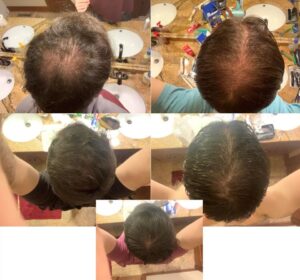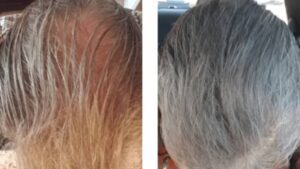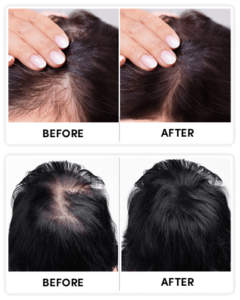The Ultimate Test: How Do I Tell What Kind of Hair Loss I Have (Permanent or Temporary)?

Getting to Know Hair Loss
Hair loss is a tough pill to swallow for many, affecting millions worldwide, regardless of age or gender. It's important to get a grip on the ins and outs of hair loss to find the right treatment and to feel comfortable with your changing looks. Whether you’re dealing with a retreating hairline or unexpected thinning, identifying the type of hair loss—temporary or permanent—can feel like solving a jigsaw puzzle. So, let’s dive into this complex topic and shed some light on what can be a confusing issue.
How Common Is Hair Loss?
Hair loss is more widespread than you might think, with about half of men and women experiencing some sort of hair thinning by the time they hit 50. While male pattern baldness often steals the spotlight, women face their own battles with hair thinning and loss. The emotional toll can be heavy, impacting self-confidence and social life. Understanding how common it is can help normalize your experience and encourage open discussions about this widespread condition.
Why Knowing Your Type of Hair Loss Matters
Why is it so crucial to figure out if your hair loss is temporary or here to stay? It's simple: different types call for different treatments. Permanent hair loss might lead you down the path of medical treatments or even surgery, like hair transplants. On the flip side, temporary hair loss could be a sign to tweak your lifestyle or tackle the root cause. Pinning down the type of hair loss early on can save you time, money, and a lot of stress, pointing you towards the best solutions.
Busting Myths About Hair Loss
Hair loss myths are everywhere, muddying the waters for those looking for clear answers. Some folks think it’s all about genetics, while others blame poor hair care. The truth? Hair loss can spring from a cocktail of factors. Getting to grips with these can bust myths and help you make informed choices. Let’s clear up these misconceptions as we explore what really causes hair loss.
What Causes Hair Loss: Temporary vs. Permanent
Genetic Factors Behind Permanent Hair Loss
Permanent hair loss often has a genetic twist, especially with conditions like androgenetic alopecia, or what we call male or female pattern baldness. This type of hair loss is heavily influenced by the genes you inherit and hormonal shifts, leading to gradual thinning. While genetics is a big player, it's not the only one, and other elements can make things worse.
Environmental and Lifestyle Causes of Temporary Hair Loss
Temporary hair loss can be triggered by various environmental and lifestyle factors. Stress, poor diet, and rapid weight loss are usual suspects, along with harsh hair treatments and hairstyles that pull at the scalp. The silver lining? Once you tackle these issues, your hair often makes a comeback, making lifestyle changes a crucial piece of the puzzle.
Why The Ancient Samurai Warriors Never Lost Their Hair…

guaranteed to work for any men or women out there...
Learn moreMedical Conditions That Can Cause Hair Loss
Various medical conditions can lead to either temporary or permanent hair loss. Conditions like alopecia areata can cause sudden, patchy hair loss, while thyroid issues, anemia, and autoimmune diseases can also take a toll on your hair. Pinpointing a medical cause is key for effective treatment and usually needs a doctor’s expertise.
How Can I Tell If My Hair Loss Is Permanent or Temporary?
Spotting the Pattern of Hair Loss
The first step in figuring out what’s happening with your hair is to look at the pattern. Permanent hair loss often follows a predictable path—like receding hairlines or thinning at the crown for guys, and widening parts or overall thinning for gals. Meanwhile, temporary hair loss might be more spread out or occur in patches, depending on what's behind it.
Looking at How Fast Hair Loss Happens
The speed at which you’re losing hair can also offer important clues. Permanent hair loss is usually a slow burn, taking months or years, while temporary hair loss can come on suddenly or follow a specific event. Keeping a record of your hair loss over time can help you and your doctor spot patterns and possible triggers.
Getting a Pro’s Opinion
If you’re unsure, visiting a dermatologist or hair specialist is a smart move. These pros can do thorough assessments and give tailored advice, helping you figure out the type of hair loss you’re dealing with and the best steps to take. Their know-how is invaluable in navigating the complex world of hair health.
Diagnostic Tests and Tools
Scalp Biopsy for a Clear Diagnosis
Sometimes, a scalp biopsy might be suggested to get to the bottom of the problem—no pun intended. This involves taking a tiny sample of scalp tissue to look at under a microscope, which can show if hair follicles are being replaced by scar tissue, a sign of permanent hair loss.
Blood Tests to Find Underlying Issues
Blood tests can be crucial in uncovering health problems contributing to hair loss. Checking thyroid function, iron levels, and hormone balances can reveal conditions that, once treated, can significantly improve hair health.
Top Trichologist: Do This To Your Scalp To Regrow A Full Head Of Hair

Completely natural and dirt cheap way that makes it possible for you to finally regrow all your hair back.
Watch nowThe Hair Pull Test and What It Tells Us
The hair pull test is a simple yet helpful method used by dermatologists to assess hair loss. By gently tugging on a small bunch of hair, they can see if you’re shedding more hair than usual, which can help diagnose the type of hair loss.
Treatment Options for Different Hair Loss Types
Medications for Tackling Permanent Hair Loss
Permanent hair loss, especially androgenetic alopecia, might be managed with medications like Minoxidil or Finasteride. These can slow down hair loss and in some cases, even kickstart regrowth. But you’ve got to use them under medical supervision to ensure they work well and to minimize side effects.
Lifestyle Tweaks for Temporary Hair Loss
When it comes to temporary hair loss, changing up your lifestyle can make a world of difference. Eating better, cutting down stress, and avoiding harsh hair treatments can all help your hair bounce back. Sometimes, simply fixing the root issue—like a nutritional deficiency—can turn things around.
Surgical and Non-Surgical Options
For those looking for quicker results, surgical options like hair transplants can be a solution for permanent hair loss. Non-surgical treatments such as laser therapy or platelet-rich plasma (PRP) injections are also gaining traction for their potential to spur hair growth without surgery.
Lifestyle and Dietary Tips
How Nutritional Supplements Can Help
Good nutrition is crucial for keeping your hair in top shape. Supplements like biotin, omega-3 fatty acids, and vitamins A, C, and E can support hair health, but it’s best to approach them with care and ideally under a pro’s guidance to avoid any negative effects.
Managing Stress for Better Hair Health
Stress is a common culprit behind temporary hair loss, so bringing stress management techniques into your daily routine can be really helpful. Practices like mindfulness meditation, yoga, and regular exercise can lower stress levels, possibly slowing down hair loss and boosting overall health.
Watch Your Hair Come Back FASTER Than You EVER Dreamed Possible

WITHOUT Expensive Medications, Lasers, or Painful Surgeries!
Watch nowGentle Hair Care to Prevent More Loss
Being kind to your hair is key to preventing more loss. This means using gentle shampoos, staying away from excessive heat styling, and picking hairstyles that don’t pull on your hair. Treat your hair with care, and it’ll thank you by staying healthier and more vibrant.
Preventive Steps and Long-Term Management
Spotting Hair Loss Early and Keeping Tabs
Catching hair loss early and keeping an eye on it can really boost how well treatments work. By monitoring changes in your hair’s thickness and texture, you can catch issues early and seek expert advice quickly.
Tailor-Made Hair Care Routines
A hair care routine that’s just right for you can make a huge difference in managing hair loss. This might mean using specialized products, adjusting how often you wash your hair, or adding scalp massages to boost blood flow and promote hair health.
Accepting Changes and Getting Support
Embracing changes in your hair with confidence can be empowering. Psychological support, whether through therapy or support groups, can help you handle the emotional side of hair loss, helping you maintain a positive self-image no matter what your hair looks like.
Wrapping Up and Moving Forward
Key Takeaways
Understanding whether your hair loss is permanent or temporary is the key to finding the right treatments and management strategies. By looking at factors like the pattern and speed of hair loss, consulting with experts, and using diagnostic tools, you can make well-informed decisions about your hair health.
Encouragement to Reach Out for Professional Help
If hair loss is weighing on you, remember that reaching out for professional help is not just a good idea—it’s often essential for effective diagnosis and treatment. Dermatologists and hair specialists have the know-how to guide and support you on this journey, helping you move forward with confidence.
Where to Find More Info and Support
If you’re hungry for more info and support, there are plenty of resources online and through healthcare providers. Books, informative websites, and patient support groups can offer valuable insights and a sense of community as you look into your options for managing hair loss. Remember, you’re not alone, and help is just a step away.






